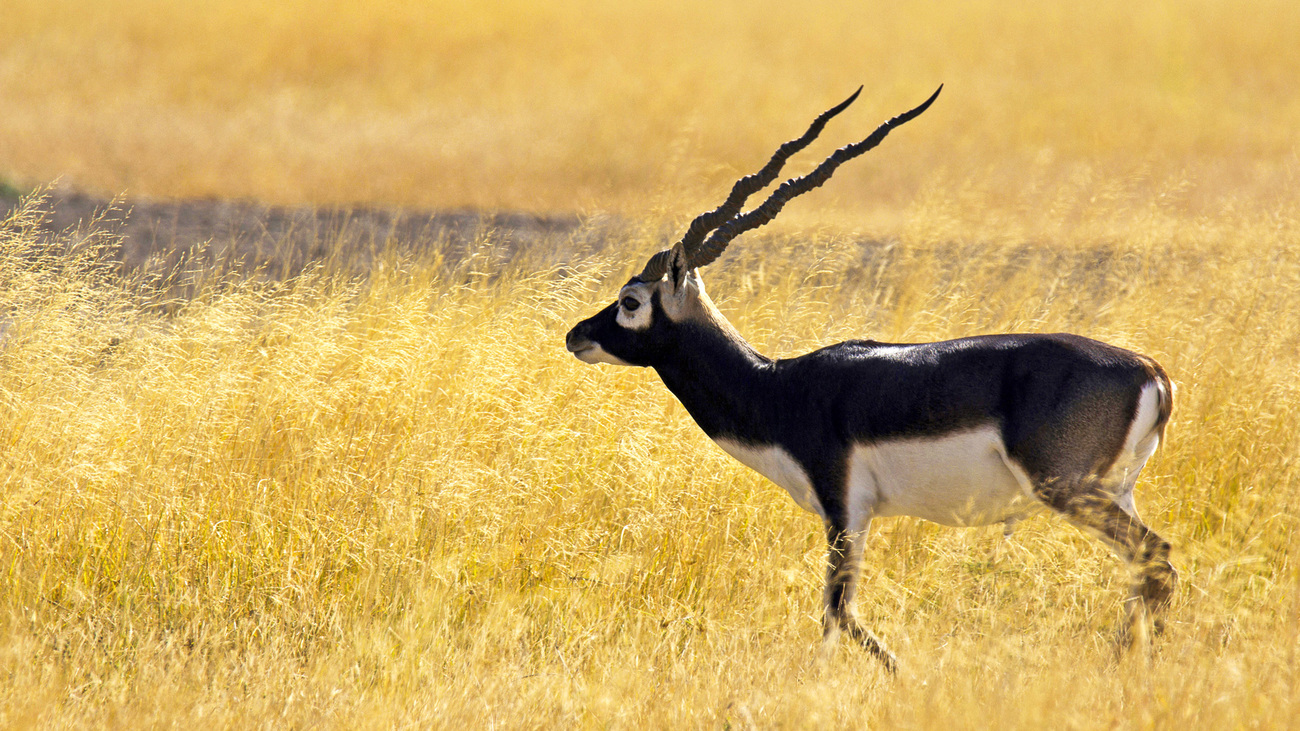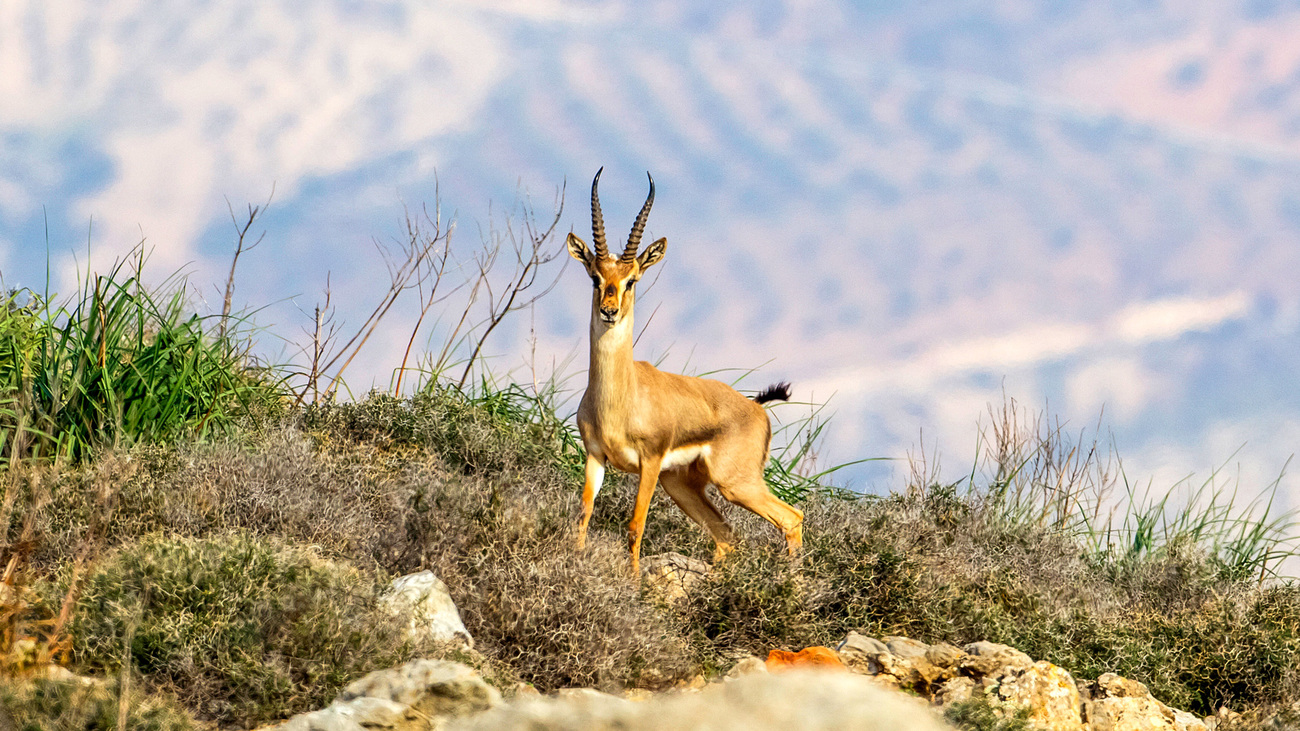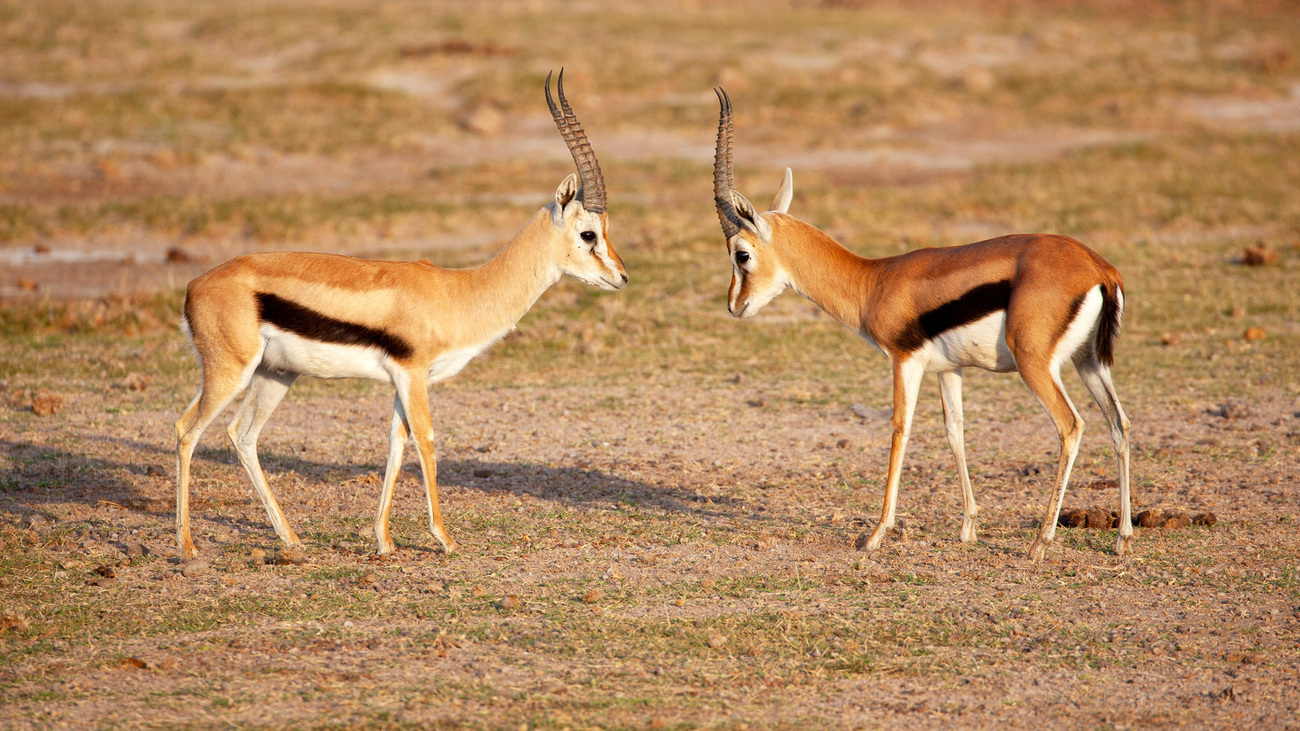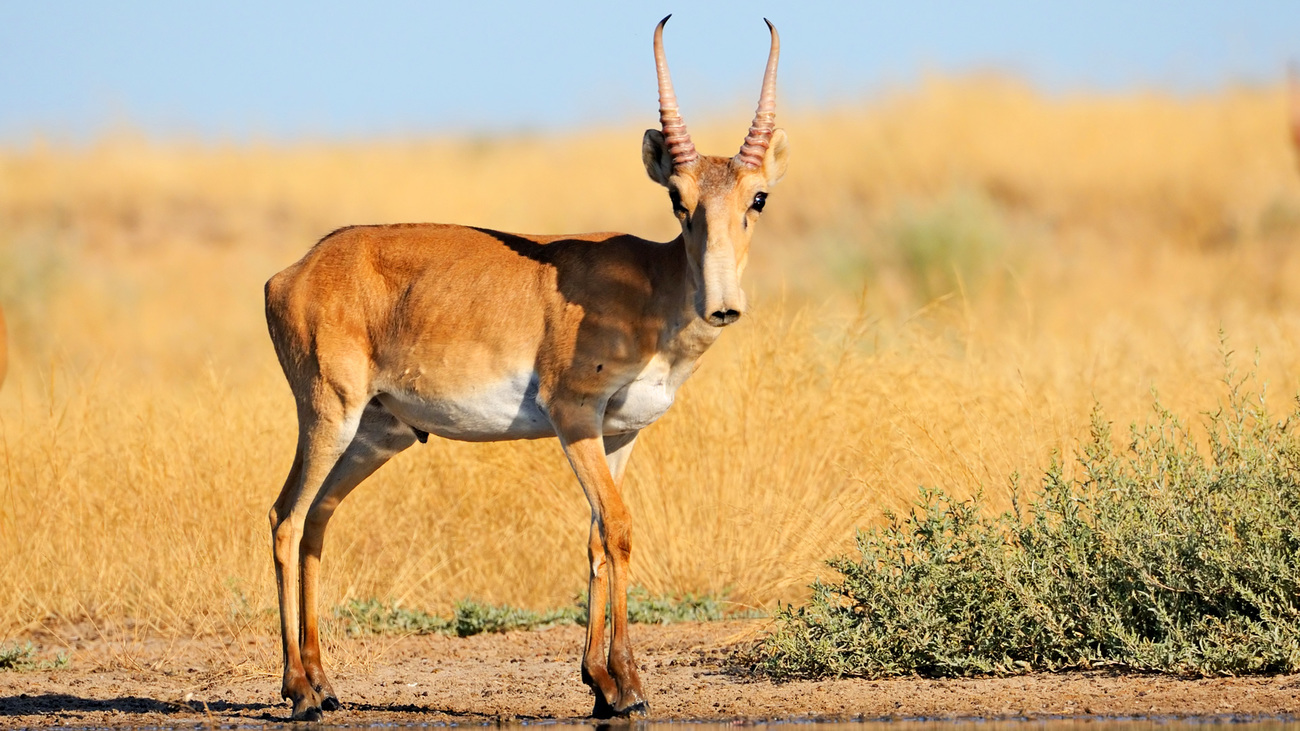Antelopes
What is an antelope?
Antelopes are hoofed mammals with hollow horns commonly mistaken for deer. The name ‘antelope’ is a catch-all term for many species in the Bovidae family. Still, scientifically, the only ‘true antelopes’ are the members of the Gazella, Nanger, Eudorcas, and Antilope genera. Other groups called antelopes include the subfamily Aepycerotinae, of which the near threatened saiga is the only living member, and the subfamily Acelaphinae, which includes the wildebeest.
Antelopes come in a staggering range of shapes and sizes, with some built for pure speed and others for agility. The largest antelope (the giant eland) can stand as tall as 182 centimetres (six feet), while the smallest (the royal antelope) is only 25 centimetres (10 inches) tall.
Some are coloured for camouflage so they can hide in their environment, while others have revealing patterns that help them stay visible to their herd.
Antelopes are cloven-hoofed ruminants with two toes and a multi-chambered stomach. Their special stomach allows antelopes to digest the fibrous plant matter they eat—plant matter that’s inedible to non-ruminant species. Their diet makes antelopes incredibly essential to their ecosystems. While the plentiful plants and grasses in any given antelope habitat amount to a huge store of potential energy, that energy would be entirely unattainable for other species without ruminants to convert it into meat. Hosts of predatory species rely on antelopes as a primary food source. In untampered conditions, this balances out since the antelopes have a plentiful source of food with minimal competition, allowing them to grow large populations that can withstand predation.
Reproductive habits vary between the many species of antelope. Gestation periods can be anything from four to nine months, and they give birth to just one or occasionally two calves at a time. Mating rituals also differ, with some solitary species pursuing monogamous relationships, while herd species often use male territories to decide which females to mate with. Some herds have dominant breeding pairs, where the dominant male gives priority to a dominant female and her young before also mating with other female herd members. When calves are born, some species hide the vulnerable young in vegetation and hunt without them, while other species can run within minutes of being born and stay with the herd at all times.
What is an antelope’s scientific name?
The many types of true antelopes and other bovids known as antelopes have their own scientific names. With 91 species in all, that’s 91 different names. Some of the true antelope species belonging to the Gazella, Nanger, Eudorcas, or Antilope genera include:
- Mountain gazelle: Gazella gazella
- Dama gazelle: Nanger dama
- Thomson’s gazelle: Eudorcas thomsonii
- Blackbuck: Antilope cervicapra
Other subfamilies that are not true antelopes but still fall under the broader antelope category include:
- Saiga
- Aepycerotinae
- Alcelaphinae
- Connochaetes
- Boselaphini
- Cephalophinae
- Hippotraginae
- Nesotraginae
- Oreotraginae
- Pantholopinae
- Peleinae
- Reduncinae
- Tragelaphini
- Antidorcas
- Oryx
Are antelopes endangered?
Different antelope species have different classifications on the IUCN Red List. Some examples include the Dama gazelle and the hirola, both of which are critically endangered. The Beisa oryx and the Scimitar-horned oryx are both endangered, and the Ader’s duiker is vulnerable. The grey rhebok is near threatened, and as of April 2023, so is the saiga—a species that was classed as critically endangered for many years and has significantly benefited from conservation efforts.
Where do antelopes live?
All living antelope species are found in Africa and Asia (including parts of the Middle East). Most species are found in Africa, while only around 14 are found in Asia. Most live in open grassland areas where they live in groups and graze on grasses, but smaller species, such as royal antelopes and duikers, live in rainforests or wooded areas, where they lead solitary lives, camouflaged by vegetation.
Threats
Threats to antelope species as a whole include predation, hunting, and climate change.

Predation
Antelopes are very important as a prey species. As ruminants, they can convert plant material that is inedible to other kinds of animals into meat that any predator can eat. Without them, the grasses would go unused, and predator numbers would decrease.
Lions, leopards, hyenas, wild dogs, cheetahs, pythons, and large birds are all types of animals that hunt and eat antelope as a primary food source. However, this level of predation can cause volatility. When external factors cause predator species to move to new areas or find new food sources, antelopes become in danger of being over hunted.
Hunting
Antelope is a popular form of bushmeat, which means antelopes aren’t just hunted by wild animals but also by humans. Hunting for bushmeat occurs in many places, even those that are protected by international regulations. Some groups of people in places like Zimbabwe have even partially domesticated eland antelopes, which they use for milk, meat, and hides. In other places, farms have been set up to raise, slaughter, and sell antelope for meat.
Aside from meat, many antelope species are also killed for their horns. As with many other animal products, antelope horns have long been used for medicinal purposes in Africa and Asia. They have also been used to make knives, reinforce shields, and create other weapons. Others believe the horn, once ground into a powder, can serve as an aphrodisiac. Before conservation efforts began to take effect, the saiga antelope was particularly affected by over hunting for its horns.
FAQs
What do antelopes eat?
Antelopes are herbivores, so their primary food source is vegetation. They eat shoots, leaves, plants, grasses, and flowers. Since as many as 91 antelope species live all over Africa and Asia, there are differences in the vegetation each species eats—and how they acquire it.
For example, the addax antelope lives in the Sahara Desert and follows rain clouds over the desert to eat the sprouting plant life after rain. On the other hand, duiker antelopes get some of their food by following groups of birds or monkeys and picking up their discarded fruits that fall to the forest floor.
A few antelope species also supplement their diet with insects and bird meat. However, leaves play the largest part in most species’ diets and act as their primary water source.
Antelopes digest their food similarly to animals like cattle, buffalo, and bison. They have special multi-chambered stomachs that allow them to break down the tough plant material they eat. The process begins when the antelope chews their food and mixes it with their saliva, which includes enzymes to help break down the plant material. In the first stomach chamber, named the ‘rumen’, this mixture gets squeezed and begins to ferment. When that’s finished, the result is called ‘cud’. Next, the cud gets regurgitated so the antelope can chew on it again, helping to further break down the plant material. Finally, the cud gets sent to a second stomach chamber where its nutrients are absorbed. Any animal with a rumen is known as a ruminant.
How many saiga antelopes are left?
The IUCN estimates that there are 922,600 to 988,500 saiga antelopes left. While they were previously listed as critically endangered, successful conservation efforts have led to a continuing rise in their population, and a re-assessment in 2023 found the species now meets the threshold for near threatened status.
Where do antelopes live?
Antelopes can be found across Africa and Asia. There are around 71 species of African antelopes and around 14 Asian species. Many types of antelopes live in open grassland, but there are some, such as small duikers, sunis, and royal antelopes, who live in the rainforests and wooded areas of Central Africa. Other species can be found in highland forests or arid bushcountry. Some species are territorial, with males defending their home ranges from each other while females roam in groups.
Antelope species were once also found in Europe and the Americas but have since gone extinct. As far as we know, there have never been any antelopes in Australia.

Is an antelope a deer?
Antelopes are not a type of deer. All antelope species are members of the Bovidae family, meaning they are related to animals like cattle and goats. Deer, on the other hand, are members of the Cervidae family. While both types of animals have antlers, if you take a closer look, they’re actually quite different in appearance.
Antelope antlers don’t branch out, and they curve slightly backward. Deer antlers branch out into many points, and unlike antelopes, they shed their antlers each year and regrow them.
Antelopes can also be substantially larger than deer, with the biggest species weighing up to 907 kilograms (2,000 pounds), while the heaviest deer weigh around 408 kilograms (900 pounds).
Are antelopes endangered?
There are around 91 species of antelopes altogether, and some are listed as near threatened, vulnerable, endangered, or critically endangered on the IUCN Red List. Some of the endangered species include the critically endangered dama gazelle and hirola, the endangered beisa oryx and scimitar-horned oryx, the vulnerable Ader’s duiker, and the near threatened grey rhebok and saiga antelope. The saiga antelope was listed as critically endangered for many years, but conservation efforts have led to a significant population increase.
Do antelopes shed their horns?
No. Unlike deer, antelopes keep their horns for their entire lives. They grow continuously, reaching lengths of up to 160 centimetres (63 inches) in some species.
Are gazelles antelopes?
Gazelles fall under the ‘true antelope’ classification, and they’re members of the genus Gazella. All types of gazelles are antelopes, but there are other types of antelopes that are not gazelles.
How big is an antelope?
The many species of antelopes vary greatly in size. The smallest species include the royal antelope, which weighs a tiny two kilograms (eight pounds) and is just 25 centimetres (10 inches) tall, and the largest—the giant eland—averages around 800 kilograms (1,800 pounds) with a shoulder height of 182 centimetres (six feet).
Do female antelopes have horns?
Around two-thirds of antelope species have horned females. This includes gazelles and oryxes. Hornless female species include sitatunga, red lechwe, and suni. In most cases, female horns tend to be smaller and shorter than male horns.

What does an antelope look like?
With different sizes, habitats, and diets, the many species of antelopes vary in appearance. Some have short, straight horns like the duiker, while others like the greater kudu have spiralling corkscrew horns. While each species has its unique elements, some general appearance traits are shared by those who live in open habitats compared to those in closed habitats.
For example, duikers, reedbucks, and bushbucks live in closed habitats such as rainforests and highland forests. They tend to be small to medium in size, with well-muscled hind legs that allow them to dart between patches of cover to hide from predators. Their colouring is optimised for camouflage, and they tend to live alone or with a mate to avoid being easily spotted.
On the other hand, antelope species that live in open grasslands are larger and built for running at high speeds. They rely on this speed to outrun predators when they get spotted, which happens often since their colouring is more striking. They tend to live in larger groups.
How can you help?
Conservation efforts are vital to protecting antelopes. We’ve already seen how some, like the saiga antelope, can benefit from such work and return from the brink of extinction.
